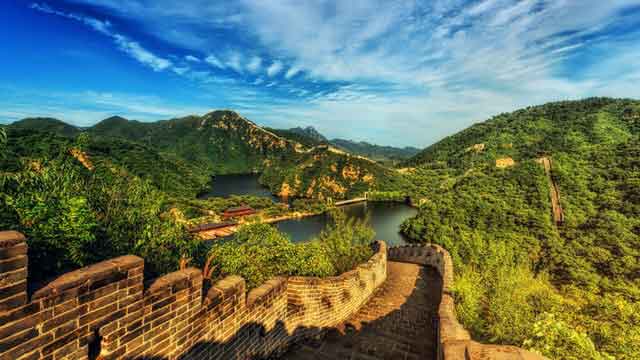The greatest wall ever built, the ancient wall still stands today. A long fence or wall is a part of a building that is commonly erected to mark building boundaries and prevent foreigners from entering the building without permission. On a larger scale, giant wall fences have also been erected by rulers in the past to protect cities or even countries. Here are top 5 amazing ancient walls around the world:
Ancient walls in the world.
1. Great Wall of China.
The Great Wall of China is a tourist spot that has become the main icon of this bamboo curtain country. While on vacation to China, you must visit this tourist spot. The Great Wall of China is a symbol of Beijing greatness. This giant wall was built along the winding mountains.
Its length, which reaches 10,000 kilometers, makes the Great Wall clearly visible from the moon. The Great Wall of China has been built since the 7th century BC during the Zhoi Dynasty. Formerly built to hold off invaders from the Xiongnu Tribe in the north. Previously these walls were made separately, it wasn’t until 221 BC, when the Qin State unified China that the great walls were united.
Apart from visiting the Great Wall of China for a historical tour, considering that this great wall is a historical relic that is more than 2000 years old, here you can also enjoy the amazing views of the Chinese landscape. Because the Great Wall of China is very long, there are several accesses to the location. There are three locations that are well-known and frequently visited by tourists, namely Badaling, Mutianyu, and Simatai.

The Great Wall at Badaling is the first part of the great wall that is open to the public and is the most visited by tourists. Badaling itself is in Yanqing County. The wall here is narrow at the top and broad at the base, looks very sturdy and remains clean because it is made of large stones mixed with mud and stone blocks in the inner material.
Between a radius of 300 to 500 meters, you’ll find a two-story fortress that served as a battle tower in ancient times. Near Badaling is the museum and the National Theater of the Great Wall of China. In 1987, Badaling was registered as a world cultural heritage by the United Nations.
Is it true that the Great Wall of China is visible from space?
While a popular myth, seeing the Wall from space with the naked eye is challenging. However, astronauts have reported that it’s visible in certain conditions, highlighting its massive scale.
How were the materials transported to build such an extensive structure in ancient times?
The construction involved a colossal effort, utilizing manual labor, horses, and even a rudimentary form of the wheelbarrow. Stones, bricks, and other materials were transported over challenging terrain.
2. Sacsayhuaman, Peru.
Who says the Great Wall only exists in China? A traveler who visits the former Inca heritage in Cusco, Peru, can see a large wall called Sacsayhuaman. No less amazing than the Great Wall of China!
Machu Picchu is not the only legacy of the Incas in Peru. There is also Sacsayhuaman, a large and magnificent wall that is no less amazing. This wall is in the vicinity of Cusco which was once the capital of the Inca Empire.
Like the Great Wall of China, Sacsayhuaman is also shaped like a fortress. What remains of Sacsayhuaman, however, is a three-tiered zigzag-shaped fortress located at different heights. All the fort buildings were made of very sticky stones, not even a single sheet of paper could fit between the stones.

A grassy path spreads between the walls. At the very top, there are three stone towers that reach 8.5 meters high. The longest wall measures 400 meters, with a height of 6 meters. With the rocks sticking together, it is estimated that one row of walls weighs 120-200 tons!
During the Inca Empire, Sacsayhuaman is thought to have been made around 900-1200. Although it is said to be a fortress, some argue that Sacsayhuaman is a temple built to worship the sun god.
When the Spanish invaded Cusco around the 1500s, they began to renovate Sacsayhuaman and use its stones to create a new city. Including, houses for officials from Spain.
Therefore, the remaining wall is now deliberately abandoned because the stone is too big. Even so, not a few tourists are amazed by the splendor of Sacsayhuaman. Although not as famous as Machu Picchu, this great wall is one of the most amazing remains of the Incas.
Why is Sacsayhuaman often considered a mystery?
The mysterious aspect of Sacsayhuaman lies in the precision with which the enormous stones were cut and placed together, leaving historians and archaeologists in awe. The intricate craftsmanship raises questions about the methods used by the Incas.
Are there any theories explaining the purpose of Sacsayhuaman?
Various theories surround the purpose of Sacsayhuaman, from a military fortress to a ceremonial site. The mystery deepens as experts explore its potential role in ancient rituals, giving travelers a fascinating glimpse into the multifaceted history of the Incas.
3. Kumbhalgarh Fort, India.
So far, people only know that the great wall only exists in China. They will not believe that a similar wall exists in India until they see it for themselves. This is the Great Wall of India, which is called the Kumbhalgarh Fort.
Located 85 kilometers on the north of Udaipur, Rajasthan, India. Kumbhalgarh Fort is the second most important fortress after Chittorgarh in Mewar territory. This fort was built in the 15th century by Maharana Kumbha and is one of 32 forts built by Rajput the ruler of Mewar.
The fort is surrounded by a perimeter wall of 36 kilometers with a width ranging from 15 to 25 meters. The size is so large and long makes the construction process take up to a century. This is done to ensure that the wall used as a shield will never be penetrated by the enemy.

Many people claim that this is the second longest Great Wall in the world after the Great Wall of China so they call it The Great Wall of India. Kumbhalgarh Fort has seven large gates and seven fortresses reinforced by a round watchtower.
Within this protective wall there are also magnificent temples and palaces were at the top there is the name “Badal Mahal” or Palace of Clouds. From the top of the palace, travelers can see the Aravalli Range and the Thar desert dunes.
Legend has it that during construction, Maharana Kumbha experienced construction difficulties so that through his spiritual advisor he had to sacrifice humans voluntarily. Then found people who were willing to volunteer to be sacrificed. Near the main gate there is a shrine in memory of these volunteers.
What are the most unique temples in Kumbhalgarh Fort?
Kumbhalgarh Fort houses several ancient temples, including the Neelkanth Mahadev Temple and the Vedi Temple. These religious structures reflect a harmonious blend of artistry and spirituality, offering a captivating experience for visitors.
What’s the best time to visit Kumbhalgarh Fort?
The ideal time to explore Kumbhalgarh Fort is during the winter months (October to March), when the weather is pleasant. The fort’s grandeur and the surrounding landscape are best enjoyed without the scorching heat of summer. Kumbhalgarh Fort is easily accessible by road from Udaipur, approximately 85 kilometers away. Travelers can hire taxis or use public transportation to reach this historic gem nestled in the Aravalli hills.
4. Walls of Constantinople (Istanbul City Walls), Turkey.
Turkey is a country that is mostly located on the Asian continent, but a small part is in Europe. The city of Istanbul is an example of a city in Turkey, which is located in the European part of the country. Before the name Istanbul, the city was best known as Constantinople.

In the past, Constantinople was the capital of the Byzantine or Byzantine Empire. Because Constantinople was vulnerable to invasion by foreigners, the city was protected by a very thick and multi-layered layer of walls.
Since the eastern part of Constantinople was the sea, the Constantinople Wall was built to the west of the city. To the west again, there is another wall called Theodosius Wall which serves as the outermost layer of defense from enemy ground forces.
Only when the Wall of Theodosius was successfully penetrated by enemy troops would the Wall of Constantinople shows its role as protector of the city. The Wall of Constantinople is 12 meters high and 4 meters thick. To make the walls, even more difficult for the enemy to break through, the Wall of Constantinople was also equipped with hundreds of giant towers.
Even though it is protected by a very strong wall and defense system, it does not mean that the city of Constantinople cannot be penetrated at all. In 1204, the city was conquered by the Crusaders. Byzantium after that had experienced a collapse, but was successfully re-established in 1261.
In 1453, it was the turn of the Ottoman troops to conquer Constantinople. This incident at the same time ended the history of Byzantium forever. The city of Constantinople was subsequently made the new capital of the Ottoman Empire. The remains of the Walls of Constantinople can still be found today in the city of Istanbul.
What makes the Walls of Constantinople unique?
These walls are renowned for their sheer scale and engineering brilliance. Stretching over 6.5 kilometers, they include various towers and gates, showcasing the architectural prowess of the Byzantine Empire.
Why were the Walls of Constantinople built?
The walls were constructed to safeguard the capital of the Byzantine Empire from external threats. They served as a formidable defense against invading forces, making Constantinople one of the most well-protected cities of its time.
5. Hadrian’s Wall, United Kingdom.
Hadrian’s Wall is a 118-kilometer-long Roman wall that was built during the Hadrian Empire. The wall was built in 122 AD, which was intended to defend the northern border of England, which was under Roman rule. Hadrian’s wall serves as an examination of the movement of the people between England and Scotland. The long and strong wall took 8 years to build.
At that time, the Roman Empire was ruled according to the personal wishes of the emperor, but the emperor’s strength rests in the army. Emperors who were weak or ill-mannered were sometimes overthrown by the generals of his army.
Some emperors ruled well, for example, Emperor Hadrian. He often goes to various places to inspect construction projects. But there were other emperors, like Nero and Caligula, who were cruel and crazy. The Romans were very good at organizing the government, so that their government continued to run smoothly even though at the center there was chaos.

Around 122 AD Roman Emperor Hadrianus ordered the building of a wall in northern England, then part of the Roman Empire, to prevent the entry of unconquered Scottish Caledonians. Made of rock and grassroots soil about 117 kilometers (73 miles) long, the wall connected a series of fortifications and watchtowers.
The Romans rebuilt Hadrian’s Wall several times throughout the 200s and 300s and used it as a fortress until about 400.The wall stretches from the Solway Firth to the mouth of the River Tyne and is about 6 meters (20 feet) high and about 2 feet wide, 4 meters (8 feet).
There was also a military road running along the southern side of the wall, and a series of fortifications and fortress posts, which were very strong, stretched along the road. The wall also marked the borders of Roman civil jurisdiction.
Some parts of Hadrian’s Wall remain in Great Britain today, especially in the center. You can even walk or ride a bicycle along the wall. This is the most popular place for tourists in Northern England. One government organization that manages historic sites in Britain calls Hadrian’s Wall “the most important monument built by the Romans in England.”
On March 13, 2010, the entire wall was lit by 500 flares of gas, flames and torches with a distance of 250 meters. More than 1,000 volunteers help celebrate the 1,600th anniversary of the end of Roman rule in England.
What is the best time to visit Hadrian’s Wall?
The best time to visit is during the spring and summer months, when the weather is milder. This ensures a more enjoyable experience as you traverse the wall and appreciate the scenic surroundings.
Are there significant archaeological sites along Hadrian’s Wall?
Yes, numerous archaeological sites dot the path of Hadrian’s Wall. These sites provide insights into Roman military life, with well-preserved forts, milecastles, and turrets waiting to be explored.

Transform Your Travels with These Must-Haves
Elevate your adventures with these indispensable travel essentials. Unleash wanderlust, buy now, and embrace exploration!
Further Reading.
We hope you found this article useful. If you want to read more, here is a selection of articles you might like:
- To see all the articles about travel destinations and tourism topic categories, visit my Travel Destinations page.
- Looking for travel news, tips, and guides you can find more on Travel News.
- If you are interested in my review, check out: Travel Adapter with 4 USB (SandRed) All in One Power Adapter, Smart Charging Electrical Adapters for Travel Type C Type A Type G With the SublimeWare “SMART” USB hub technology.
- Get ready to be amazed as we uncover Amazing Obscure Locations You Never Knew Existed.
- Sony ZV-1 Camera for Content Creators, Vlogging and YouTube with Flip Screen and Microphone, Recreate the world in your image, The ZV-1 is designed to bring together simplicity and power, opening up creative opportunities as wide as your imagination.
- Take a look at this packing list, Travel Essentials, that you can finally rely on. Recommend to pack for any vacation, the best way to pack a backpack is to save space.
- If you liked this article, then please subscribe to our YouTube Channel and Dailymotion Channel for Inspiring travel videos from around the world.
- Affiliate Disclaimer: Many of the links above are affiliate links, and as an Amazon Associate, I earn from qualifying purchases. If you click on them and make a purchase, I’ll receive a small commission (at no cost to you) and really appreciate your support.
- Thank you for visiting. Please feel free to come again anytime.

